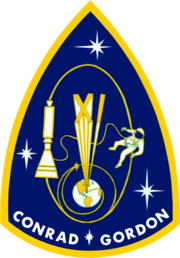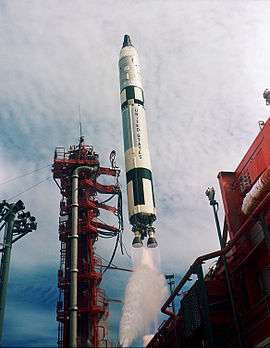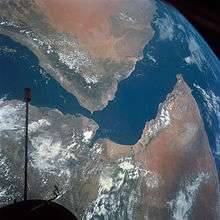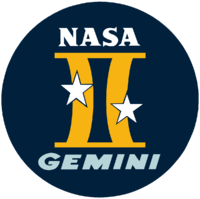Gemini 11
 Gemini XI conducting a tether experiment using the Agena Target Vehicle | |||||
| Operator | NASA | ||||
|---|---|---|---|---|---|
| COSPAR ID | 1966-081A | ||||
| SATCAT № | 2415 | ||||
| Mission duration | 2 days, 23 hours, 17 minutes, 9 seconds | ||||
| Orbits completed | 44 | ||||
| Spacecraft properties | |||||
| Spacecraft | Gemini SC11 | ||||
| Manufacturer | McDonnell | ||||
| Launch mass | 3,798 kilograms (8,374 lb) | ||||
| Landing mass | 1,920 kilograms (4,230 lb) | ||||
| Crew | |||||
| Crew size | 2 | ||||
| Members |
Charles "Pete" Conrad, Jr. Richard F. Gordon, Jr. | ||||
| EVAs | 2 | ||||
| Start of mission | |||||
| Launch date | September 12, 1966, 14:42:26 UTC | ||||
| Rocket | Titan II GLV, | ||||
| Launch site | Cape Kennedy LC-19 | ||||
| End of mission | |||||
| Recovered by | USS Guam | ||||
| Landing date | September 15, 1966, 13:59:35 UTC | ||||
| Landing site | 24°15.4′N 70°0′W / 24.2567°N 70.000°W | ||||
| Orbital parameters | |||||
| Reference system | Geocentric | ||||
| Regime | Low Earth orbit | ||||
| Perigee | 298 kilometers (161 nmi) | ||||
| Apogee | 1,368 kilometers (739 nmi) | ||||
| Inclination | 28.8 degrees | ||||
| Period | 101.57 minutes | ||||
| Epoch | September 14, 1966[1] | ||||
| Docking with GATV-5006 | |||||
| Docking date | September 12, 1966, 16:16:00 UTC | ||||
| Undocking date | September 14, 1966, 16:55:00 UTC | ||||
| Time docked | 2 days, 39 minutes | ||||
 .jpg) (Left to Right) Gordon & Conrad
| |||||
Gemini 11 (officially Gemini XI))[2] was the ninth manned spaceflight mission of NASA's Project Gemini, which flew from September 12 to 15, 1966. It was the 17th manned American flight and the 25th spaceflight to that time (includes X-15 flights over 100 kilometers (54 nmi)). Astronauts Charles "Pete" Conrad, Jr. and Richard F. Gordon, Jr. performed the first-ever direct-ascent (first orbit) rendezvous with an Agena Target Vehicle, docking with it one hour and thirty-four minutes after launch; used the Agena rocket engine to achieve a world record high-apogee earth orbit; and created a small amount of artificial gravity by spinning the two spacecraft connected by a tether. Gordon also performed two extra-vehicular activities for a total of 2 hours and 41 minutes.
Crew
| Position | Astronaut | |
|---|---|---|
| Command Pilot | Charles "Pete" Conrad, Jr. Second spaceflight | |
| Pilot | Richard F. Gordon, Jr. First spaceflight | |
Backup crew
| Position | Astronaut | |
|---|---|---|
| Command Pilot | Neil A. Armstrong | |
| Pilot | William A. Anders | |
Support crew
- Clifton C. Williams, Jr. (Cape CAPCOM)
- John W. Young (Houston CAPCOM)
- Alan L. Bean (Houston CAPCOM)
Mission parameters
- Mass: 8,374 pounds (3,798 kg)
Highest orbit (followed twice):
- Perigee: 156.4 nautical miles (289.7 km)
- Apogee: 739.2 nautical miles (1,369.0 km)[3]
- Inclination: 28.85°
- Period: 101.52 min
Docking
- Docked: September 12, 1966 - 16:16:00 UTC
- Undocked: September 14, 1966 - 16:55:00 UTC
Space walk
- Gordon - EVA 1
- Start: September 13, 1966, 14:44:00 UTC
- End: September 13, 1966, 15:17:00 UTC
- Duration: 0 hours, 33 minutes
- Gordon - EVA 2 (stand up)
- Start: September 14, 1966, 12:49:00 UTC
- End: September 14, 1966, 14:57:00 UTC
- Duration: 2 hours, 08 minutes
Objectives
- Perform a direct-ascent rendezvous with the Agena Target Vehicle on the first orbit in support of Project Apollo. This would simulate a Lunar Module rendezvous with the Command/Service Module after a lunar landing.
- Use the Agena rocket engine to put the combined craft in a high-apogee elliptical orbit.
- Perform two Extra-vehicular activities.
- Demonstrate passive attitude stabilization of the two spacecraft connected by a tether, and create artificial gravity by spinning the combined craft.[4]
- Perform miscellaneous scientific experiments.
- Perform a computer-controlled atmospheric reentry to a precision splashdown point.


| Gemini 11 | Agena info |
|---|---|
| Agena | GATV-5006 |
| NSSDC ID: | 1966-080A |
| Mass | 7,000 pounds (3,200 kg) |
| Launch site | LC-14 |
| Launch date | September 12, 1966 |
| Launch time | 13:05:01 UTC |
| 1st perigee | 156.4 nautical miles (289.7 km) |
| 1st apogee | 165.8 nautical miles (307.1 km) |
| Period | 90.56 min |
| Inclination | 28.84 deg |
| Reentered | December 30, 1966 |
Flight

The direct-ascent rendezvous and docking with the Agena vehicle was achieved approximately 94 minutes after lift-off, depending on the on-board computer and radar equipment with only minimal assistance from ground support.[4]
Gemini 11 used the rocket on its Agena target vehicle to raise its apogee to 850 miles (1,370 km), the highest Earth orbit ever reached by a manned spacecraft. The perigee was 179 miles (288 km), and maximum velocity (at perigee) was 17,967 miles per hour (28,915 km/h).[4] The apogee record stands as of March 2016, even though men have achieved greater distances from Earth by flying to the Moon in the Apollo program.[5] The maximum operational altitude of the Space Shuttle was lower, at 600 miles (970 km).
The crew docked and undocked four times, and still had sufficient Gemini maneuvering fuel for an unplanned fifth rendezvous. They did not remain in the high orbit, but changed it back to a near-circular one at 184 miles (296 km).[4]
Gordon's first EVA, planned to last for two hours, involved fastening a 100-foot (30 m) tether, stored in the Agena's docking collar, to the Gemini's docking bar for the passive stabilization experiment. Gordon achieved this, but as with previous Gemini EVAs, trying to do work for an extended period proved more fatiguing than in ground simulation, and the EVA had to be terminated after only half an hour.
The passive stabilization experiment proved to be a bit troublesome. Conrad and Gordon separated the craft in a nose-down (i.e., Agena-down) position, but found that the tether would not be kept taut simply by the Earth's gravity gradient, as expected. However, they were able to generate a small amount of artificial gravity, about 0.00015 g, by firing their side thrusters to slowly rotate the combined craft like a slow-motion pair of bolas.[4]
Gordon successfully performed a second EVA standing up with his head and shoulders out of the hatch to photograph the Earth, clouds, and stars. This was not tiring, and lasted more than two hours.[4]
Scientific experiments
The 12 scientific experiments were:
- Mass Determination: To test a technique and accuracy of a direct contact method of determining the mass of an orbiting object, in this case the Agena Target Vehicle.
- Night Image Intensification: To test the usefulness and performance of a low-light-level television system as a supplement to unaided vision in observing surface features primarily when such features are in darkness and spacecraft pilots are not dark-adapted.
- Power Tool Evaluation: To evaluate man's capability to perform work tasks in space, including the comparison of ability to work tethered and untethered, and to evaluate the performance of the minimum reaction power tool.
- Radiation and Zero G Effects on Blood and Neurospora: To determine if a synergistic relationship exists between weightlessness and radiation on white blood cells and neurospora.
- Synoptic Terrain Photography: To obtain high-quality photographs for research in geology, geophysics, geography, oceanography, and related fields.
- Synoptic Weather Photography: To obtain selective high quality photographs of clouds to study the fine structure of the Earth's weather system.
- Nuclear Emulsion: To study the cosmic radiation incident on the Earth's atmosphere, to obtain detailed chemical composition of the heavy primary nuclei, and to search for rare particles.
- Airglow Horizon Photography: To measure by direct photography the heights at which atomic oxygen and sodium layers occur in the upper atmosphere.
- Ultraviolet Astronomical Camera: To test the techniques of ultraviolet photography under vacuum conditions and to obtain ultraviolet radiation observations of stars in wavelength region of 2,000 to 4,000 Angstroms by spectral means.
- Ion Wake Measurement: To determine and measure the ion and electron wake structure and perturbation of the ambient medium produced by an orbiting vehicle, and to study the changes in the ion flux and wake caused by thruster firings.
- Earth-Moon Libration Region Photography: To investigate the regions of the L4 and L5 libration points of the earth-moon system to determine the possible existence of clouds of particulate matter orbiting the earth in these regions.
- Dim-Light Photography and Orthicon: To obtain photographs of various faint and diffuse astronomical phenomena.[6]
Reentry
The mission ended with the first totally automatic, computer-controlled reentry by the U.S., which brought Gemini 11 down 2.8 miles (4.5 km) from its recovery ship USS Guam, only 1.5 miles (2.4 km) from the planned position.[4]
The Gemini 11 mission was supported by 9,054 United States Department of Defense personnel, 73 aircraft and 13 ships.
Insignia

As Conrad and Gordon were both members of the US Navy, the embroidered mission patch was designed in Navy colors: blue and gold. Stars are used to mark the major milestones of the mission. The first orbit Agena rendezvous is marked by a small gold star just above the Earth, to the left. The Agena docking is marked by a large star on the left. The star at the top marks the record high apogee reached by Gemini 11. Note that the scale is greatly exaggerated; their maximum altitude of 850 miles (1,370 km) is roughly the distance from St. Louis to Cape Kennedy. Finally, the star on the right marks Dick Gordon's spacewalk. The docking, record apogee and spacewalk are also shown on the patch by the Agena, orbital apogee path and spacewalking astronaut.
Spacecraft location
_at_California_Science_Center.jpg)
The spacecraft is on display at the California Science Center in Los Angeles, California.
See also
- Agena Target Vehicle
- Extra-vehicular activity
- List of spacewalks
- Splashdown
- Space exploration
- U.S. space exploration history on U.S. stamps
- Space capsule
- Space suit
Notes
![]() This article incorporates public domain material from websites or documents of the National Aeronautics and Space Administration.
This article incorporates public domain material from websites or documents of the National Aeronautics and Space Administration.
- ↑ McDowell, Jonathan. "SATCAT". Jonathan's Space Pages. Retrieved March 23, 2014.
- ↑ Hacker, Barton C.; Grimwood, James M. (September 1974). "Chapter 11 Pillars of Confidence". On the Shoulders of Titans: A History of Project Gemini. NASA History Series. SP-4203. NASA. p. 239. With Gemini IV, NASA changed to Roman numerals for Gemini mission designations.
- ↑ Dumoulin, Jim (August 25, 2000), NASA Project Gemini-XI, retrieved April 12, 2010
- 1 2 3 4 5 6 7 Gatland, Kenneth (1976), Manned Spacecraft, Second Revision, New York, NY, USA: MacMillan Publishing Co., Inc, pp. 180–182, ISBN 0-02-542820-9
- ↑ However, if Apollo had progressed as planned, the record would have been broken by what was designated as the E mission which was a medium Earth orbital test of the complete Apollo spacecraft, with an apogee of 3,500 nautical miles (6,500 km) planned to be flown in March 1969. But the first Lunar Module was not ready in time for the D mission planned for December 1968, which was a low Earth orbit test (see List of Apollo mission types). Therefore, the E mission was cancelled and replaced with the D mission in March, and Gemini 11's apogee record stands.
- ↑ "NASA Gemini 11 Press Kit" (PDF). Retrieved 2011-02-10.
External links
| Wikimedia Commons has media related to Gemini 11. |
- NASA Gemini 11 press kit - Sep 2, 1966
- Gemini 11 - 1966 NASA Space Program Educational Documentary on YouTube
- Spaceflight Mission Patches
- http://nssdc.gsfc.nasa.gov/database/MasterCatalog?sc=1966-081A
- U.S. Space Objects Registry http://usspaceobjectsregistry.state.gov/search/index.cfm

